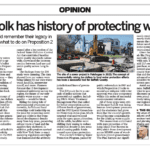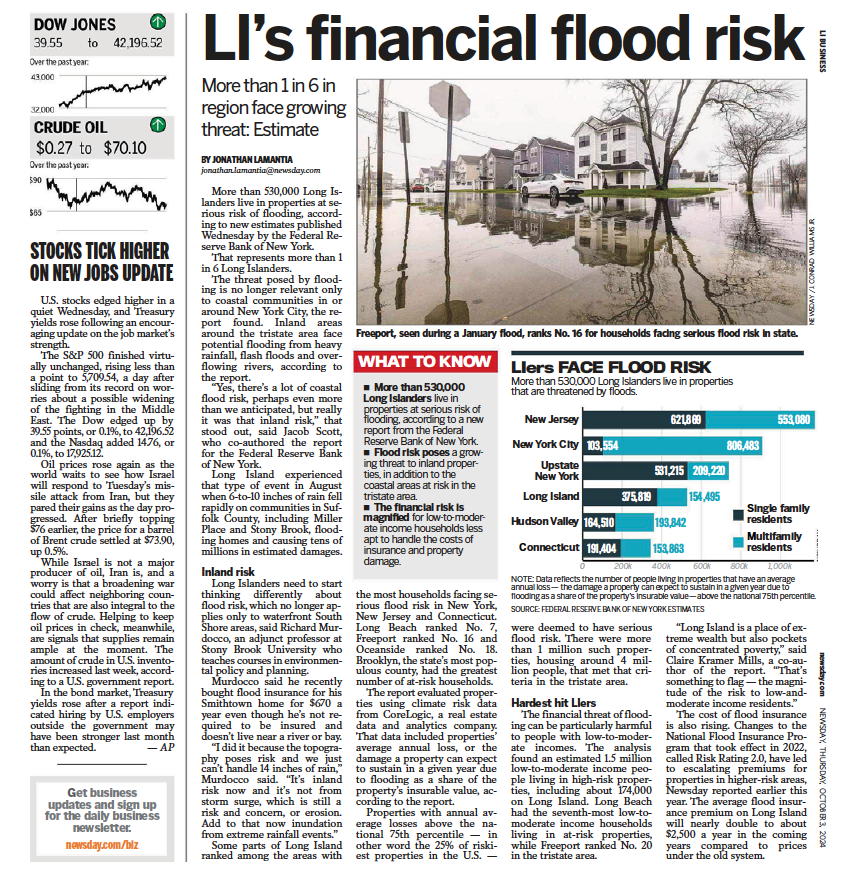The following are answers to The Foggiest Five, a set of questions asked to influential Long Islanders on the future of the region. This round features answers from Jocelyn Wenk, who is the Associate Director of the Long Island Index, a project of the Rauch Foundation. The views presented are the author’s alone, and do not represent those of The Foggiest Idea:
1. What is your favorite part of living on Long Island?
I absolutely love where I live—I can walk right into one of the nicest downtowns on Long Island, and I live just a short drive from the beach. I also love living close to family and being just a train ride away from New York City.
2. What is our greatest regional challenge?
Our greatest regional challenge is the lack of affordable housing. This is something that I know the statistics about because of my work for the Long Island Index, but I’ve also been witnessing up close in my own life.
My son just said goodbye to his best friend, a 6-year-old girl; her family is relocating from Long Island to upstate New York, where her parents recently bought a 3-bedroom home for around $150,000. That’s unimaginable on Long Island. We know from our Long Island Index survey research that nearly 60 percent of Long Islanders find it difficult to pay their rent or mortgage in an average month, and more than 75 percent are concerned that the high cost of housing will force family members to leave the region. Couples with children now constitute less than 30 percent of all households on Long Island, compared to more than 50 percent just a generation ago.
We also know that the lack of affordable housing is making it more difficult for employers to attract and retain talented workers. We said goodbye to one of our closest friends last year when she left Long Island to take a job with a growing pharmaceutical company in Westchester County; she’s a scientist with a Ph.D. who could share story after story about the derelict rental units she lived in on Long Island.
3. What is an easy first step to solving this challenge?
Detached single-family homes make up the vast majority of Long Island’s housing stock. Imagine if, in some of our neighborhoods of single-family homes, we had small backyard cottages tucked behind homes, or perhaps living space above garages. These are places where a 20-something returning from college could live, or an elderly parent. Homeowners struggling to pay their mortgages could earn additional income, and municipalities could even gain more tax revenue through the addition of new housing to the tax rolls.
For Long Islanders who may be concerned about how accessory dwelling units would look or the impacts they might have, photos on the Long Island Index’s Build a Better Burb website show how they can be surprisingly beautiful. And there are communities around the country, from Santa Cruz, CA to Seattle and Denver, to name a few, that have successfully encouraged development of these units without seeing overcrowded schools or streets turned into parking lots.
4. What has been the biggest change that you’ve seen on Long Island during the course of your career?
I moved to Long Island in 2007. During my first few years working here, the strength of NIMBY sentiment on Long Island frequently came up in conversation, and was often reported upon (a 2010 Wall Street Journal article characterized NIMBY sentiment here as among the strongest in the country). But the tide has begun to shift. This past spring, I interviewed David Viana and Karen Montalbano of the Baldwin Civic Association for an article on Build a Better Burb; they shared their incredible story about how Baldwin residents have been rallying to support new housing and shops in their downtown. Nassau County’s recent Infill Redevelopment Feasibility Study identified several communities that are ready to welcome growth in their downtowns and train station areas. Across Long Island, we’re beginning to see more and more examples of places like Patchogue that have welcomed change.
5. What do you think Long Island will be like in 20 years?
I’ll be optimistic and say that Long Island will have effectively grappled with some of our biggest regional challenges: we’ll be a place with more young families, more high-paying jobs, lower taxes, more integrated schools, more affordable housing in our downtowns and train station areas, and many more acres of open space preserved. This sounds like a place where I’d want my children to live when they grow up!
Jocelyn Wenk, AICP, is Associate Director of the Long Island Index, a project that gathers and publishes data about the Long Island region. The Index is a project of the Rauch Foundation, a Long Island-based family foundation. Ms. Wenk is Editor of Build a Better Burb, the online journal of suburban design.
Prior to working for the Rauch Foundation, Ms. Wenk worked as an urban planner in the Long Island office of AKRF, an environmental and planning consulting firm; she also served as the Long Island office’s acting head. She began her career as a community planning consultant in suburban Detroit.
Ms. Wenk is a trustee of the Society for the Preservation of Long Island Antiquities, the Long Island region’s nonprofit historic preservation organization. She is a member of the Class of 2011 of the Energeia Partnership, Molloy College’s regional stewardship and leadership academy. Ms. Wenk graduated magna cum laude and Phi Beta Kappa from Princeton University, and she has a master of urban planning from the University of Michigan.









